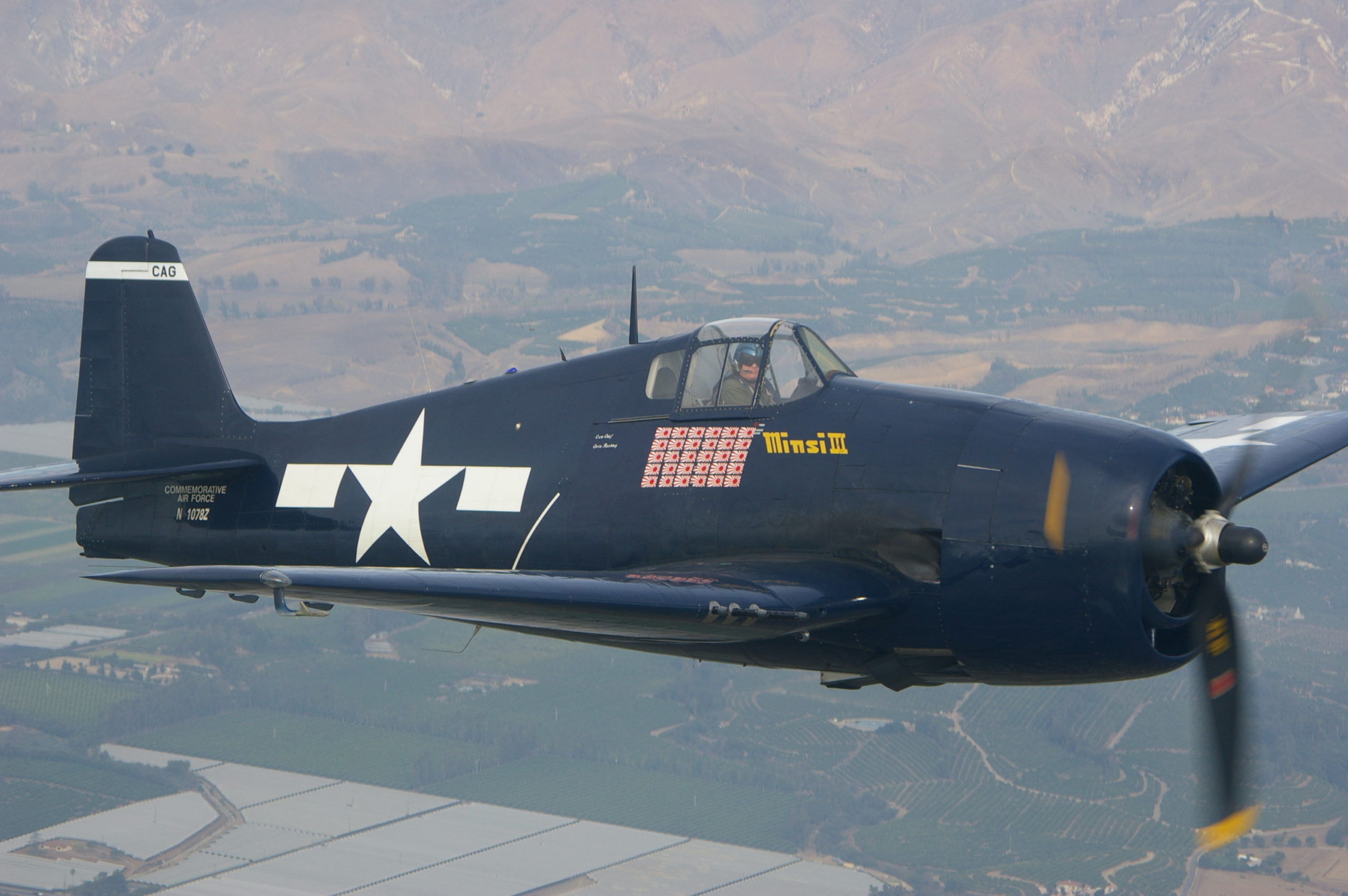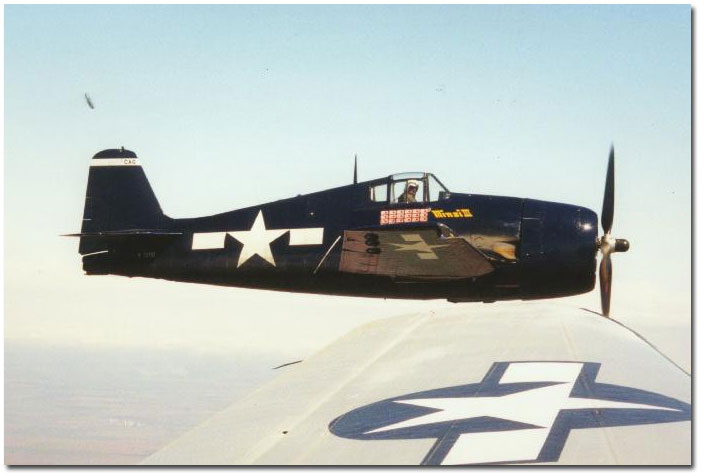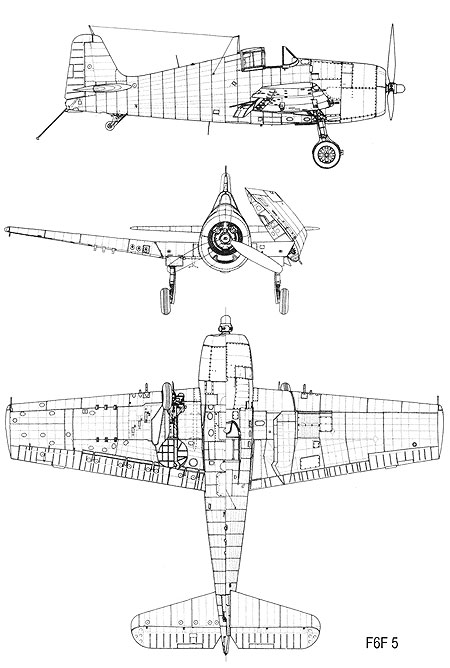GRUMMAN F6F-5 HELLCAT U.S. NAVY FIGHTER #27354801-66 N1078Z
Here is our F6F-5 Hellcat in flight. It has been painted in the colors of Cmdr. David McCampbell, USN, Air Group Commander of VF-15 on the USS Essex during WWII.
Specifications GRUMMAN-F6F-5-HELLCAT
Origin: Grumman Aircraft Engineering Corporation
Type: Single-seat ship borne fighter – also fighter-bomber and night fighter
Dimensions:
Span 42′ 10″ (13.05 meters)
Length 33′ 7″ (10.2 meters)
Height 13′ 1″ (3.99 meters)
Weight (F6F-3):
Empty: 9,042 lb (4,101 kg)
Loaded: (clean) 12,186 lb (5,528 kg)
Loaded (maximum) 14,250 lb (6,443 kg)
Engine:
Early production: one 2,000 hp Pratt & Whitney R-2800-10
Double Wasp two-row radial
From Jan 1944: (final batch of F6F-3s) two-thirds had a 2,200 hp R-2800-10W
(water-injection rating).
Armament:
6 x 0.5 inch Browning machine-guns
with 400 rounds per gun. (Some F6F-5 and F6F-5N Hellcats had 2 x 20 mm cannon plus 4 x 0.5 inch machine-guns) Under-wing attachments for six rockets Center-section pylons for up to 2,000 lb of bombs
Performance:
Maximum speed (clean) 376 mph
Initial climb (typical) 3,240 feet per minute
Service ceiling 37,500 feet
Range 1,090 miles
A ‘Bar Sinister’ Hellcat’ – The interesting history of the CAF’s Grumman F6F Hellcat
by Bill Coombes Copyright © 1998 by the Confederate Air Force and Bill Coombes.
All rights reserved. Originally published in The Dispatch magazine, Volume 23, Number 3, Fall, 1998 edition. Edited April 2021.
“All of the airplanes in the CAF fleet have checkered pasts: after all, most things fifty years old or more are bound to have interesting tales to tell. The CAF’s Hellcat, N1078Z, is certainly no exception, and one could even say its past is more unusual than most. The tale of this ‘Cat begins with a bit of an identity crisis. It seems that our Hellcat should more accurately be termed an Alley Cat, as its official designation, according to the FAA, is “S & S Special Grumman F6F.” It is a parts airplane, consisting mainly of an F6F-3 fuselage mixed with a considerable number of F6F–5 parts and modifications. It even has the brakes off its arch rival the F4U Corsair. Its lineage, then, is rather difficult to assess, and our ‘Cat’s story all starts with the first owner, Col John Sandberg of Minneapolis, MN .
It was Col Sandberg who discovered this particular airframe or at least the majority of it, derelict on the airport at Fergus Falls, Minnesota in 1961. As Sandberg said, it was “a real bad airplane,” having been stripped of everything removable and then used for target practice by the locals. Several important things were missing, big pieces as well as little. In the later category were the Grumman data plate and any Navy serial number, making the identification and establishment of ownership “interesting.” The airport manager accepted the responsibility of selling the hulk and soon Sandberg found himself the owner of most of the pieces of an F6F. After temporary yet time-consuming repairs, the Hellcat was ferried back to Minneapolis, and the next two years were spent restoring the big Grumman and registering it with the proper authorities.
There was some initial thought given to using the Hellcat for aerial photography, and then there was a plan to race the rather chunky fighter. Toward this outcome the wings were clipped seven inches on each panel, the inter-cooler openings in the cowling were filled in, and a general lightening of the airframe was done. Several years later, Sandberg decided to part company with the Hellcat after an engine failure and subsequent forced landing. After repairing the airplane it was flown to Harlingen for an airshow and left there. Sandberg said he would be willing to sell it to the CAF if a sponsor could be found for it. Col Lloyd Nolan, sensing an opportunity not to be passed by, bought the airplane for $20,000. Several months later, in the fall of 1970, Col Ed Messick bought the airplane from Nolan with the assurance that it would continue to fly with the CAF. Messick later donated the Hellcat to the CAF.
Some restoration of the airplane was done, and it flew with the CAF fleet regularly until a variety of problems kept the F6 grounded. First was a problem with the fuel tanks de-laminating, which led to the need for a new engine, one of three it has had, which was followed by some hydraulic problems. While these problems were being attended to, the airplane acquired a new paint scheme, its former VF-12 USS Randolph giving way to a tri-color blue over blue over white Navy scheme, with markings as used on Lt. Francis Fleming’s VF-16 Hellcat, circa 1943. However, a series of nagging mechanical gremlins kept appearing.
By 1986, the Hellcat was one very tired airplane, badly in need of a major restoration. Col Joe Mabee stepped forward to accept responsibility for 1078Z and in July of that year it arrived at Classic Aero, Inc., at Mabee Ranch to begin what would become a 12 year project. Initial examination of the airplane revealed some interesting items. For starters, the wings were still clipped, although they had the correct tips on them, fitted with liberal amounts of Bondo; the flaps worked, asymmetrically on occasion; two of the four upper cowl flaps were bolted shut; the oil cooler shutter was bolted open; the hydraulic system needed a complete rebuild from the sump out to each individual system; almost all the tubing in the entire airplane leaked and needed to be replaced; and the induction system, cobbled together out of aluminum and galvanized flex tubing was “quite a mess,” in the words of Classic Aero’s Ken Shugart.
Additionally, the main and tail wheel tires were deeply gouged; the hinge mechanism for folding the wings was seriously corroded; the wiring was “heat treated,”being generally old, cracked and worn; more Bondo had been used all over the airplane to disguise forty years worth of dents and dings; and the entire horizontal stabilizer was loose, moving about ½ inch in all directions. On the plus side, the engine checked out perfectly! With a determination to see the F6F back in the skies, Col Mabee gave Shugart the go-ahead and work commenced. For every step forward, two steps back were taken as new problems manifested themselves. This, coupled with Shugart’s desire to make 1078Z an Oshkosh winner, slowed work.
When one sees the big ‘Cat today, with fully 50 percent of the skin on the entire airplane being new, with an entirely hand-built induction system, all new tubing throughout the airframe, etc., one realizes that this is essentially a factory-fresh Hellcat, rebuilt by essentially a two man crew. A few new sponsors came forward, but the primary financial responsibility, which was significant, was borne by Col Mabee until Col David Price stepped into the picture in October of 1995 to provide funding to finish the Grumman.
Today, 1078Z has completed its test flights and has performed flawlessly. Painted in the 1944 Navy scheme of all-over dark blue with white markings, the big fighter makes a beautiful sight against the white clouds and clear skies over CAF Headquarters. Such sights, common fifty years ago, serve to remind us of the need to keep these magnificent aircraft in the air, as a reminder to all Americans of the accomplishments and sacrifices, for us today, of yesterday’s generation.”



